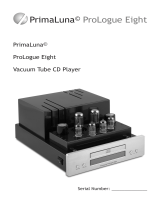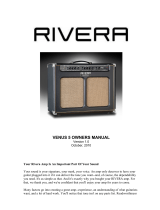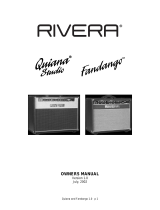VAC Vintage Preamplifier Owner's manual
- Category
- Audio amplifiers
- Type
- Owner's manual
This manual is also suitable for

Valve Amplification Company
1731 Northgate Boulevard, Sarasota, FL 34234 USA
Telephone 941-359-2066 / Fax 941–359-2057
www.vac-amps.com
VAC VINTAGE PREAMPLIFIER Mk III
Operating Instructions
DO NOT OPEN THIS UNIT - THERE ARE NO USER SERVICEABLE PARTS INSIDE.
DO NOT TOUCH TUBES UNTIL UNIT HAS BEEN SWITCHED OFF FOR 5
MINUTES. TUBES BECOME HOT IN USE. DO NOT EXPOSE THIS UNIT TO
MOISTURE. DO NOT PLUG INTO AN AC SOURCE UNTIL ALL CONNECTIONS
ARE COMPLETED.
Introduction
The Vintage Preamplifier features a zero-global-feedback, Class A, triode line amplifier &
controller, and a Class A triode phono amplifier employing both passive and active RIAA
equalization techniques. It is to be operated from the voltage labeled on the back panel, 50-
60 Hz. The fuse is a slow blow type of the size labeled on the back of the unit.
Connection
1.Complete all connections before connecting the AC cord to the wall outlet.
2.At turn on, the volume control should be full counter-clockwise and the mode switch
should be set to MUTE. Also, always MUTE the preamp before switching power off,
to prevent damage to amplifiers or speakers.
3.Allow 30 seconds for warm up before leaving MUTE.
4.The Vintage Preamplifier inverts phase from all inputs to the main outputs. To correct
for this reverse the speaker connections in both channels. Output to the tape jacks
does not invert.
5.In normal operation no signal is present at the tape output jacks. This is done to
ensure that no degradation of sound occurs due to input non-linearities or loading

effects of the tape recorder. To record, select the record enable position ("TAPE ON")
of the TAPE MONITOR switch. If you wish to monitor the output from the recorder's
monitor head (if so equipped) select the monitor position ("MON"). It is
recommended that this switch not be cycled during important recordings.
6.Tube compliment is:
V112AX7A/E83CCphono input amplifying triode - LOW NOISE
V212AX7A/E83CCphono input amplifying triode - LOW NOISE
V312AX7A/E83CCphono amplifying triode
V412AX7A/E83CCphono impedance translator triode
V512AX7A/E83CCphono impedance translator triode
V612AU7A/E82CCline amplifying triode
V712AX7A/E83CCline impedance translator triode
7.XLR balanced outputs (optional) follow the EIA standard convention, where the
positive phase signal is carried on pin 2 and the inverted phase is carried on pin 3.
Many manufacturers fail to follow the standard.
8.Some systems will sound different depending on the polarity of the AC line cords.
Many audiophiles experiment with the relative cord polarity of their components. In
general, incorrect relative power polarity will result in a somewhat thin and wispy
sound. We recommend that you consult your dealer for suggestions.
Tube Types
Golden Dragon tubes are generally recommended and have been used extensively during the
development of this amplifier. Please feel free to contact VAC if you require additional
information or advice.
About Microphony
Every amplifying device, be it tube or transistor, produces some output with mechanical
stimulation (microphony). In fact, even cables possess microphony. In the Vintage
Preamplifier, V1, V2, V3, and V6 will emit a sound through the speakers if directly struck.
This is a normal situation. The exact amount of sound depends on the tube type, its location
in the circuit, and slight random variations in tube manufacture. When the chassis itself is
struck sharply there may be either no sound or a slight sound emitted from the speaker, but it
should die away rapidly. Again, this is normal and not representative of the type of

mechanical or acoustic stimulation encountered when the unit is properly installed and
playing music. Replace the offending tube if excessive mechanical sensitivity or ringing
occurs.
It is best not to subject the tubes to tapping or the chassis to repeated mechanical jars, as this
may damage the precision of the tubes and cause them to become more microphonic.
About Noise
Every amplifying device produces some amount of noise. In fact, even a resistor produces
noise in the presence of current flow. Acceptability is not a question of whether this
characteristic is present but rather the degree to which it is present.
The most likely source of phono stage noise are tubes V1 & V2. The audibility of noise
produced in the phono stage is influenced by the output level of your phono cartridge.
Pickups with output levels lower than approximately .4 mV may be problematic. With a
pickup rated at .4 mV output and low noise 12AX7s (V1, V2), the subjective level of
electronic noise will be approximately 1/3 of the groove noise on a good direct to disc
recording.
The most likely source of line stage noise is V6. The audibility of noise produced in the line
stage is not affected by the volume control setting, and is determined by the sensitivity of the
power amplifier and the efficiency of the speakers. With a speaker of extremely high
efficiency (for example, a Klipschorn) the preamplifier itself may be modified by VAC for
more appropriate noise and output levels. Noise should be insignificant with speakers in the
typical efficiency range.
Need Help?
Please call us with any questions you may have. It is better to ask than to guess!
-
 1
1
-
 2
2
-
 3
3
VAC Vintage Preamplifier Owner's manual
- Category
- Audio amplifiers
- Type
- Owner's manual
- This manual is also suitable for
Ask a question and I''ll find the answer in the document
Finding information in a document is now easier with AI
Related papers
Other documents
-
Manley Absolute Owner's manual
-
Manley Absolute Headphone Amplifier Owner's manual
-
Mesa/Boogie Tigris Audiophile User manual
-
Cary Audio Design SLP-94 Owner's manual
-
 PrimaLuna USA pmn User manual
PrimaLuna USA pmn User manual
-
Mesa/Boogie OOGIEBMESA User manual
-
 Rivera VENUS 5 Owner's manual
Rivera VENUS 5 Owner's manual
-
Audio Note M2 Balanced informatio Specification
-
 Rivera Fandango Owner's manual
Rivera Fandango Owner's manual
-
JONARD TOOLS RDT-18K Operating instructions






